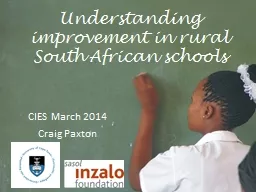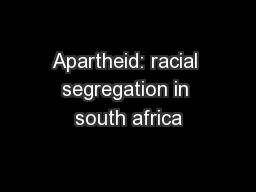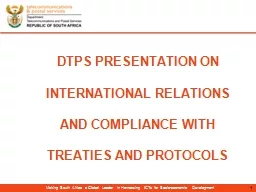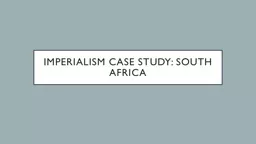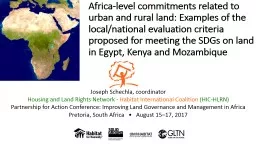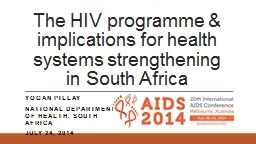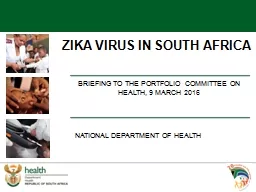PPT-Growing sustainable rural schools in South Africa
Author : cheryl-pisano | Published Date : 2016-05-03
UKFIET Sept 2015 Craig Paxton The Five Essential Supports Bryk et al 2010 amp Sebring 2013 Five essential supports Ambitious instruction classes are challenging
Presentation Embed Code
Download Presentation
Download Presentation The PPT/PDF document "Growing sustainable rural schools in Sou..." is the property of its rightful owner. Permission is granted to download and print the materials on this website for personal, non-commercial use only, and to display it on your personal computer provided you do not modify the materials and that you retain all copyright notices contained in the materials. By downloading content from our website, you accept the terms of this agreement.
Growing sustainable rural schools in South Africa: Transcript
UKFIET Sept 2015 Craig Paxton The Five Essential Supports Bryk et al 2010 amp Sebring 2013 Five essential supports Ambitious instruction classes are challenging and engaging Learning climate . Presented by. Lulu Kahla . a) How was life in South Africa during the Apartheid Era.. b) Changes were made after gaining Democracy in 1994.. c) Challenges facing South Africa today. History Before Apartheid. . 1,500 years ago: . Bantu. migration south. 1600’s: . 1. st. Europeans (Dutch East Indies Company-settle in Cape Town) became known as . Afrikaners. (. af. -. rih. -KAHN-. Its European Invasion . and Struggle with Apartheid . SS7H1C: Explain the creation and end of apartheid in South Africa and the roles of Nelson Mandela and F. W. DeKlerk . Essential Questions???. What events led up to apartheid?. DTPS PRESENTATION ON INTERNATIONAL RELATIONS AND COMPLIANCE WITH TREATIES AND PROTOCOLS. 1. Making South Africa a Global Leader in Harnessing ICTs for Socio-economic Development. 2. Objectives of International Relations. Sharpeville to Modern South Africa. After Sharpeville. Following Sharpeville, the anti-Apartheid movement followed, in parts, all of the positions represented in our simulation.. The ANC continued its non-violent approach. Netball is one of the most popular women’s sport in the world with over 20 million women. and girls playing in over 80 countries.. In 1891, James Naismith invented basketball when he nailed two peach baskets on. What is Apartheid?. Look to the right—what does this picture make you feel?. What does this picture tell you about Apartheid in South Africa?. Definition of Apartheid:. The term apartheid (from the . and Struggle with Apartheid . SS7H1C: Explain the creation and end of apartheid in South Africa and the roles of Nelson Mandela and F. W. DeKlerk . Essential Questions???. What events led up to apartheid?. Bessie Moore Center for Economic Education. Rita Littrell. Welcome to Our Guests. Bessie Moore Center for Economic Education. Karen Dos Reis. Alex . Pinnock. Seymour . Bothman. Rudolph . Cornelissen. * Put your name on the little map. * Colour in where you think the country of South Africa is. *Surround the map with ideas / facts / impressions you have South Africa. * Add a little frame. 2.2 Analyse specified aspects of studied visual texts supported by evidence. What do these signs appear to say?. Where do you think they are from?. Three groups clash over south . africa. . Africans, the. Dutch. , and the British clashed over land and resources in South Africa . Joseph Schechla, coordinator. Housing and Land Rights Network - . Habitat International Coalition . (HIC-HLRN). Partnership for Action Conference: Improving Land Governance and Management in Africa Pretoria, South Africa • August 15–17, 2017. Yogan. . Pillay. National Department of Health, South Africa. July 24, 2014. HIV and ART in South Africa. 6.4 . million people living with HIV and . AIDS (total population 54 million). Prevalence amongst pregnant women: 29%. BRIEFING TO THE PORTFOLIO COMMITTEE ON HEALTH, 9 MARCH 2016. NATIONAL DEPARTMENT OF HEALTH. Outline. Background to Zika virus. First case of Zika virus in South Africa. Public health implications. Actions taken.
Download Document
Here is the link to download the presentation.
"Growing sustainable rural schools in South Africa"The content belongs to its owner. You may download and print it for personal use, without modification, and keep all copyright notices. By downloading, you agree to these terms.
Related Documents

